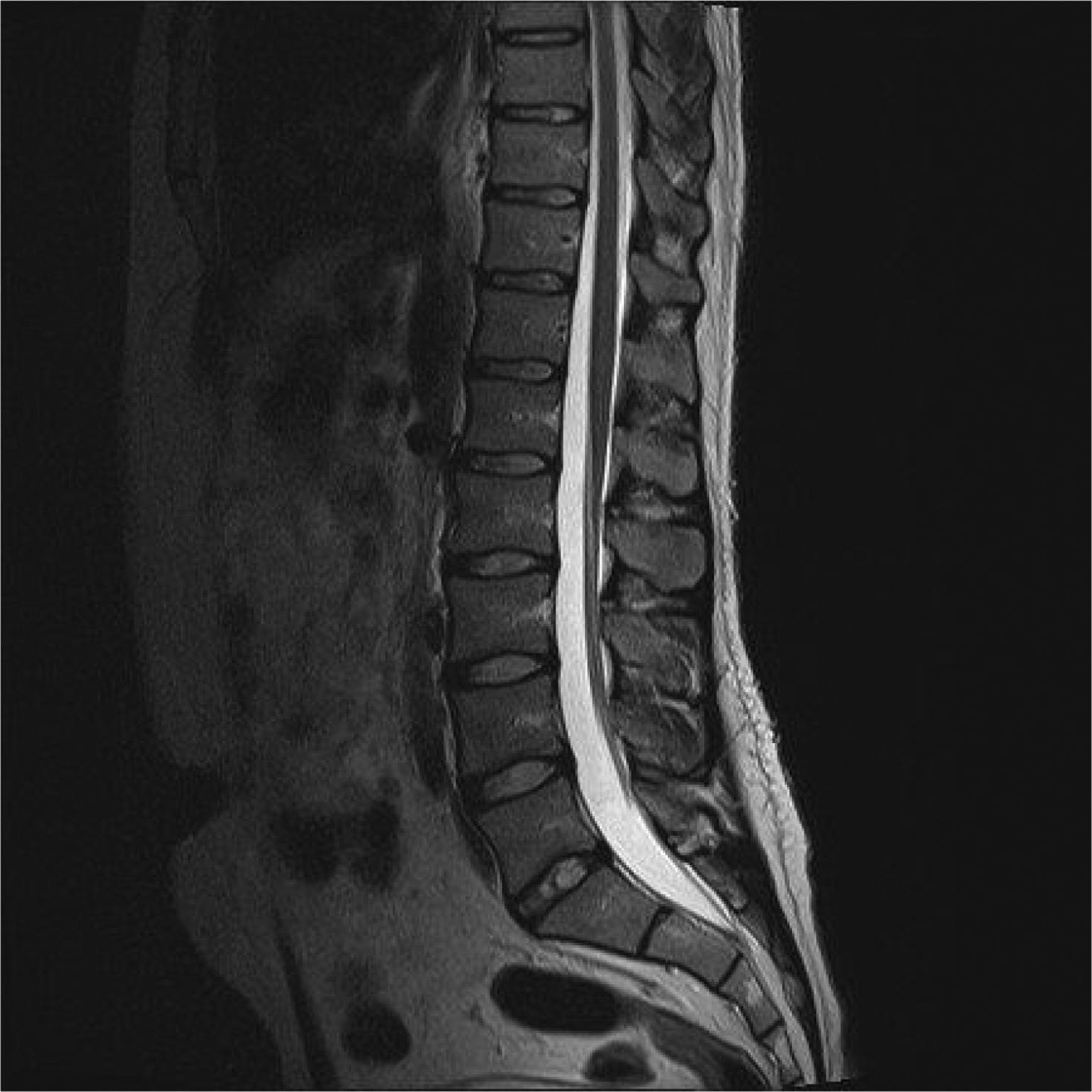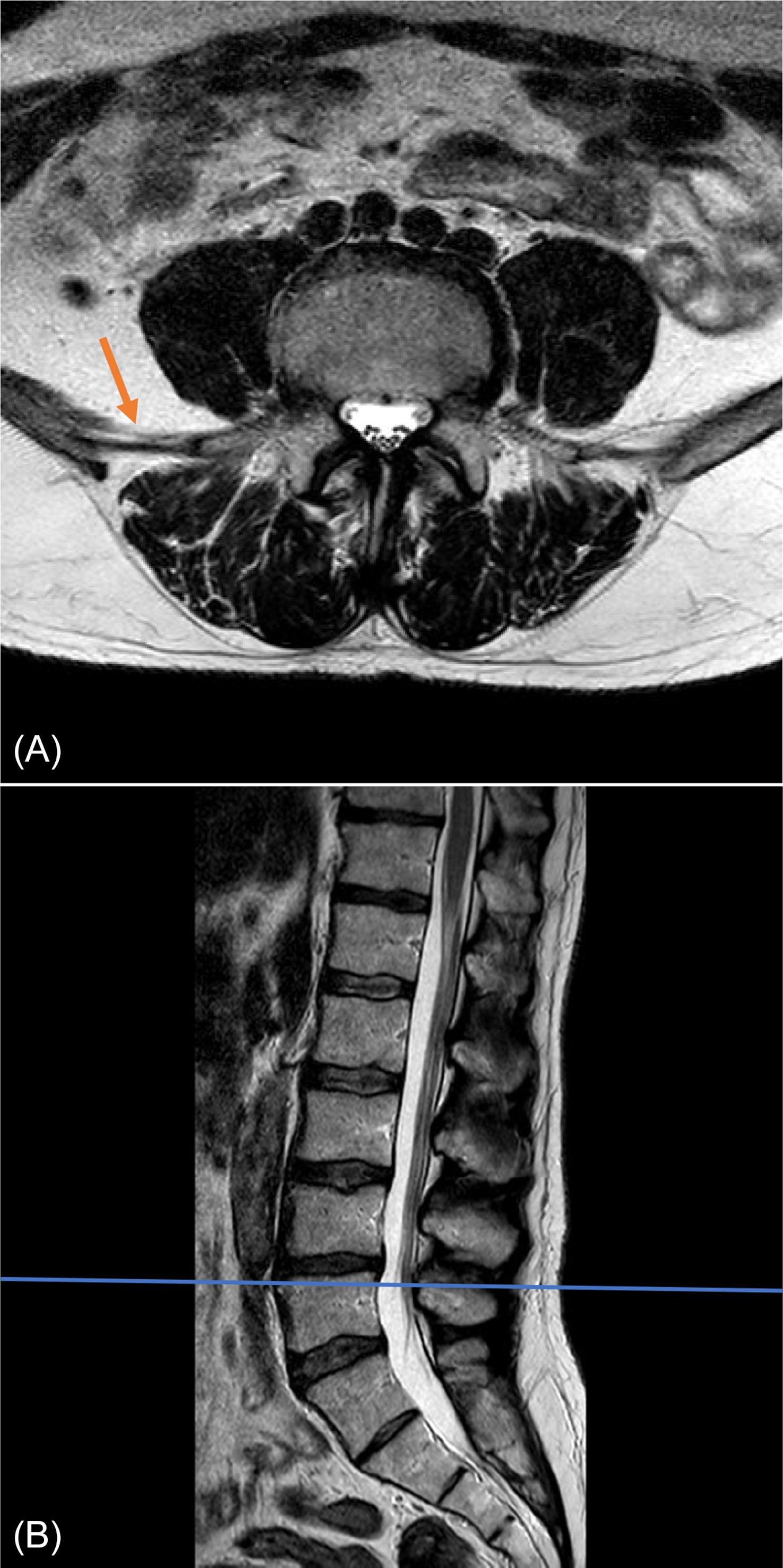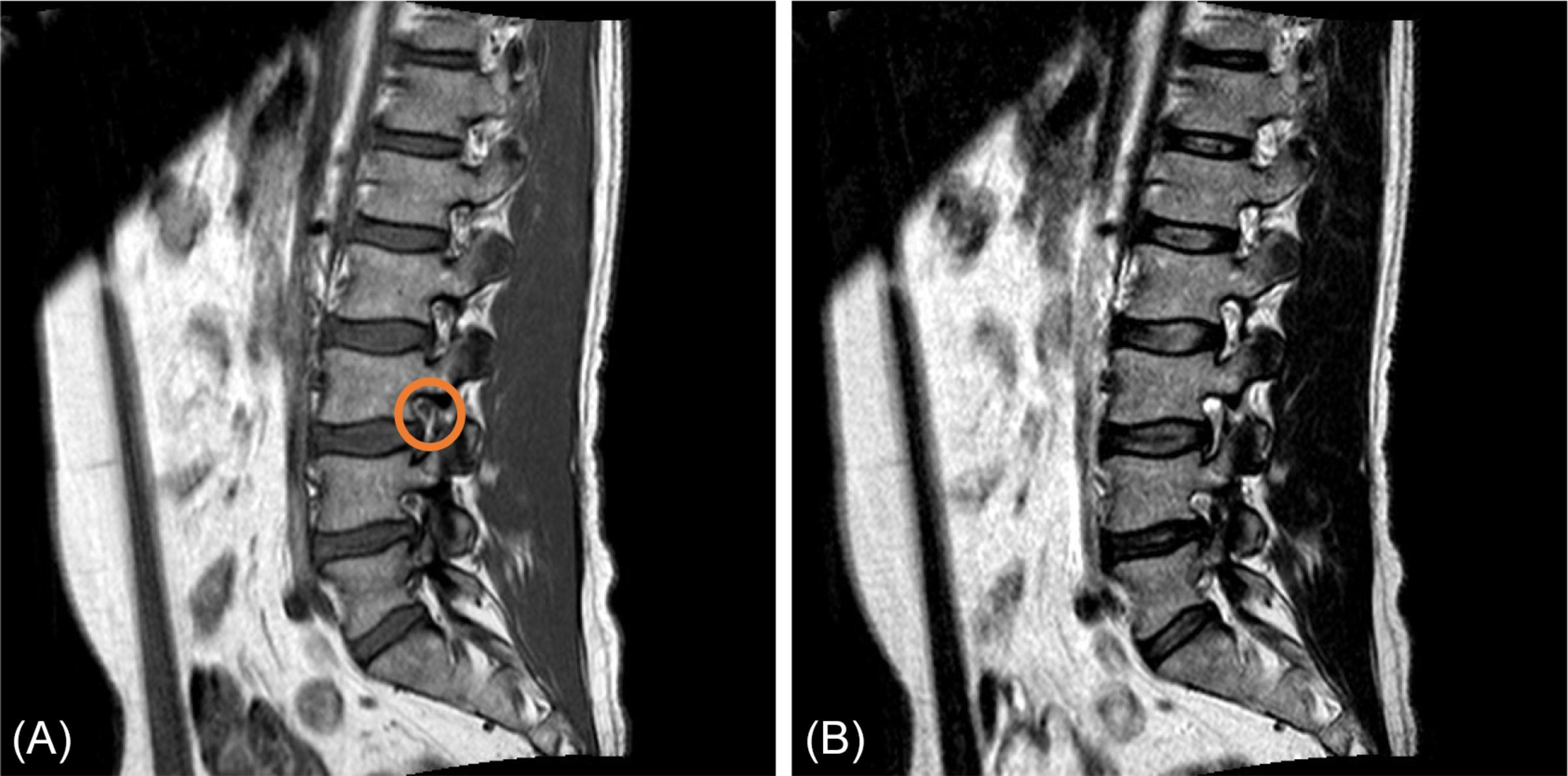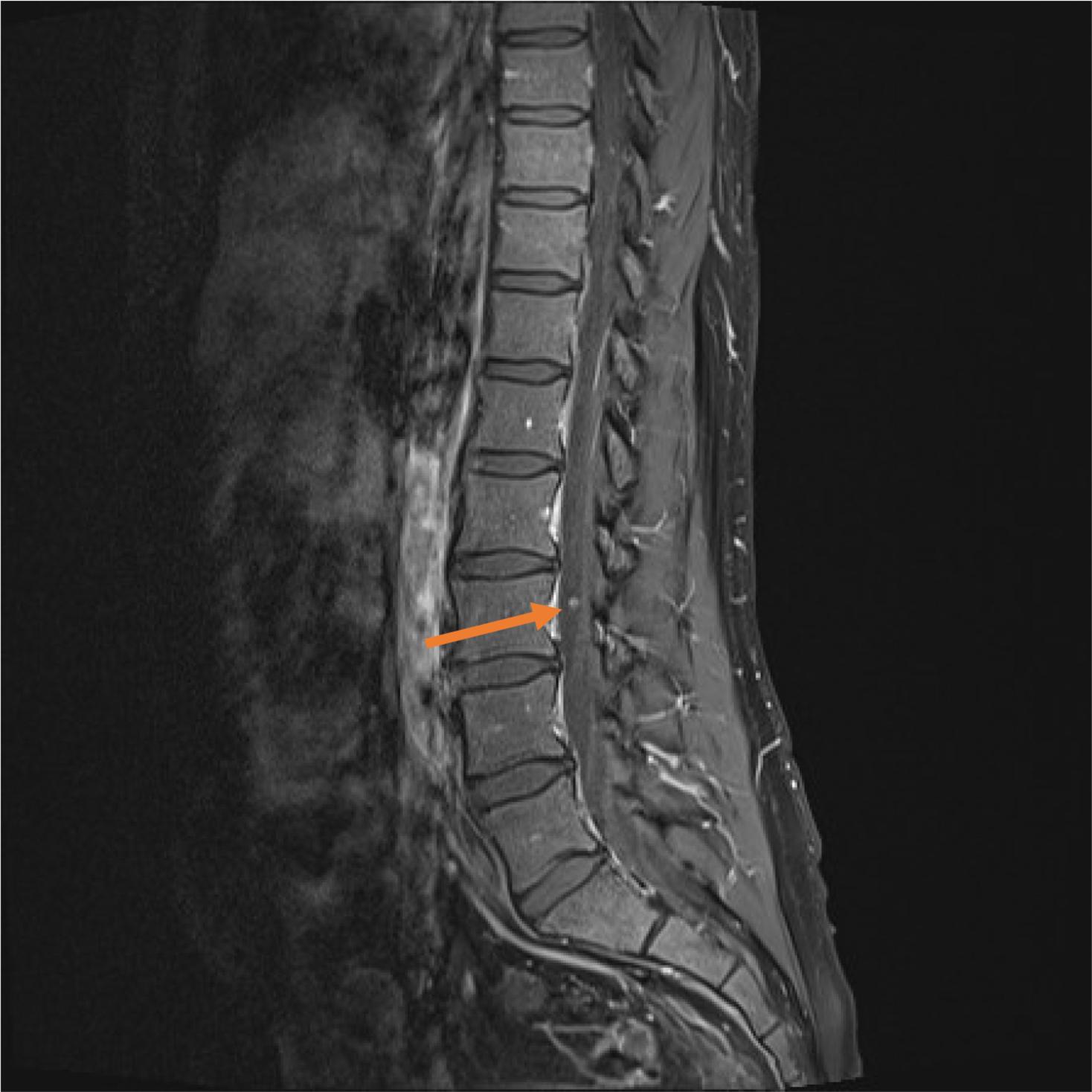Physical Address
304 North Cardinal St.
Dorchester Center, MA 02124
The lumbosacral spine consists on average of 5 lumbar vertebrae, the sacrum, and coccyx. An MRI scan of this area is used to accurately depict soft tissue in and around the lumbosacral spine. Measurements mainly focus on a change in signal intensities and less on absolute distances or angles. Various pathologies affect the configuration of the soft tissue, which can lead to clinical symptoms such as neural compression syndromes, most commonly due to degeneration, congenital disorders, and benign or malignant neoplasms. Structures visible on MRI include neural structures, meninges, cerebrospinal fluid, blood vessels, fat, ligaments, bone and joints, discs, muscles, and organs. Knowledge of normal anatomy and the systematic assessment of these structures will help to generate the most accurate and clinically relevant scan interpretation. In addition, it is important to have a clinical question in mind before requesting and assessing a lumbosacral MRI, since, for example, degenerative abnormalities are common and asymptomatic in the majority of people. More importantly, among patients without clinical signs pointing toward a specific condition, imaging does not improve patient outcomes and may lead to worse outcomes, unnecessary harm, and increased costs.
The focus of this chapter will be on normal anatomical configuration and signal intensities on MRI, but will also expand on the disruption of normal anatomy with various pathologies and their clinical correlations.
Various lumbar spine MRI scanning protocols exist, each with its own advantages and disadvantages. In this chapter, the main focus will be on sagittal and axial T2-weighted images and T1-weighted images with and without gadolinium and fat-suppressed T1- and T2-weighted images. Axial images should be scanned parallel to the endplates, while keeping in mind that the scanning direction must change as little as possible in order to facilitate the assessment of the course of the nerve roots.
The choice for specific sequences depends on the structures and pathology that need to be assessed. Table 1 shows normal T1, T2, and T1 with gadolinium enhancement (T1-G) intensities on MRI. On T1-weighted images, tissues with short T1 times like fat and bone marrow appear bright, while tissues with long T1 times, such as fluid and cortical bone appear dark. On T2-weighted images, tissues with short T2 times appear dark, as, for example, tendons, ligaments, nerves, and bone. Tissues with long T2 times are bright, as, for example, fluid in the thecal sac and joint effusions. Fat appears bright on both T1- and T2-weighted images and, therefore, fat suppression techniques are often utilized to improve visualization of structures otherwise masked by fat. Furthermore, areas with hyperpermeable blood vessels as tumors, areas of inflammation and infection can show enhancement after gadolinium administration. As it has the highest number of unpaired electrons of all elements, gadolinium can be given as a contrast fluid to evaluate the accumulation of contrast. Often, these postcontrast T1 sequences are fat-suppressed to make this enhancement more distinguishable.
| A | Alignment | Lumbar lordosis, number of lumbar vertebrae, listhesis |
| B | Bone | Vertebral body, arch, spinous processes, endplates, fractures, lesions, and ligaments (including ligamentum flavum) |
| C | Canal | Cord, conus, cauda equina, cerebrospinal fluid, epidural fat |
| D | Discs | Discs, neuroforamina, facet joints |
| E | Enhancement and extraspinal structures | Organs, muscles, fat, skin, contrast enhancement |
MR images provide a wealth of visible structures. To be complete without losing oneself in a lengthy and unnecessary maze of findings, a structured way of assessing an MRI study is useful. For this purpose, we use a modification of the ABCDE-method ( Table 1 ).
Later, the normal anatomy of these structures will be discussed first, according to the ABCDE-structure. Following the normal anatomy, various pathologies and their appearances on MRI will be explained.
Assessment of alignment should include the presence of normal lumbar lordosis and proper positioning of each vertebra on top of the other. MRI of the lumbar spine is normally obtained with the patient in supine position. Previous studies have shown that MR images taken with the patient in supine position and legs straight out were comparable with standing MRI; however, a supine position with bent hips was found to significantly reduce lumbar lordosis by approximately 6.3° (14%). Spinal alignment should be judged on sagittal T1- or T2-weighted images ( Fig. 1 ). It should be emphasized that instability cannot be assessed on a supine MRI. Deviation of vertebrae from the midsagittal plane may indicate scoliosis; however, as previously stated, MRI is not the imaging modality of choice to categorize the scoliosis, to measure angles and to make a treatment plan.

The most common number of lumbar vertebrae is five. In up to 20% of the general population lumbosacral transitional vertebrae (LSTV) are seen, of which the sacralization of L5 is the most common (~ 17%) and the lumbarization of S1 is rarer (~ 2%). Recognition of these anomalies is important as it can influence clinical decision making and help to avoid wrong-level surgery. The Castellvi classification ( Table 2 ) can be used to classify LSTV, but does not replace an accurate description of the anomaly. LSTV may be best visualized in a coronal view, because of the depiction of possible enlarged transverse processes of the lowest lumbar vertebra and the connection with the superior sacrum. However, coronal images are not routinely included in a standard lumbosacral MRI protocol. Ways to recognize LSTV on sagittal images are the recognition of the iliolumbar ligament as this is found to arise from L5 in more than 95% of people ( Fig. 2 ) and a complete S1–2 intervertebral disc. If a LSTV is seen or suspected, aforementioned characteristics should be noted, including where the lowest well-formed intervertebral disc can be found, as this can be recognized at fluoroscopy during invasive treatments.
| Type I: Enlarged and dysplastic transverse process in coronal view (at least 19 mm) |
|
| Type II: Pseudoarticulation of the transverse process and sacrum with incomplete lumbarization/sacralization; enlargement of the transverse process with pseudoarthrosis |
|
| Type III: Transverse process fuses with the sacrum and there is complete lumbarization or sacralization, enlarged transverse process with complete fusion |
|
| Type IV: Type IIa on the one side and Type IIIa on the contralateral side |

Bony and bone-related structures that need to be assessed are vertebral body, arch, spinous processes, endplates, fractures, lesions, and ligaments. The vertebral body is the largest part of the vertebral column and in its upper part arise two pedicles, which are connected to two laminae. These, together, form the vertebral arch, connected to a spinous process in a normal situation. The vertebral body is oval-shaped in the axial plain and square in the sagittal plane. Its upper boundary is formed by the upper endplate and the lower boundary is formed by the lower endplate, which are normally symmetrically concave-shaped and without disruptions in young people. With age and degenerative processes, endplates can become thinner and even completely absent. Whether the endplate belongs to the disc or the vertebral body is still debated, since it encompasses both an osseous component as well as a hyaline cartilage component. In young patients, mainly under the age of 25, areas of focal fat deposition are common in the posterior elements of the vertebral body, as well as areas of high vascularity, due to conversion and reconversion processes. These areas include the subendplates and subcortical zones and also the area surrounding the basivertebral vein in the middle of the vertebral body ( Fig. 1 ). This is a normal aging process of conversion and reconversion, expressed by the replacement of red marrow by yellow marrow, and should not raise suspicions when encountered. Other frequent and usually not pathological lesions in vertebral bodies are hemangiomas and vertebral enostosis.
The most important ligaments of the lumbar spine are the anterior longitudinal ligament (ALL) running in front of the vertebral bodies and intervertebral discs from the pelvic surface of the sacrum inferiorly to the anterior tubercle of C1 and basilar portion of the occipital bone superiorly, the posterior longitudinal ligament (PLL) running posteriorly over the vertebral bodies and discs from the sacrum to C2. It then extends as the tectorial membrane at the level of the odontoid. The ligamentum flavum connects the inner lamina, interspinous ligaments, and supraspinous ligaments. Ligaments and also cortical bone appear hypointense on both T1 and T2 and exhibit a slim and regular appearance.
The vertebral arches surround the spinal canal. This canal contains the thecal sac with the spinal cord above the L1-L2 level, cauda equina below this level and the conus at the interface of spinal cord and cauda equina floating in cerebrospinal fluid. Cerebrospinal fluid is hyperintense on T2 and hypointense on T1. However, flow voids can mimic a hypointense signal on T2. The neural structures are normally iso- to hypointense on T1- and T2-weighted images. Nerves of the cauda equina can be followed along their course running from the thecal sac through the lateral recess and foramen intervertebralis to the neural plexus. The nerve is normally running just below the pedicle. This is above the level of the discus in the foramen intervertebralis. The nerve is surrounded by fat, which makes it assume the shape of an oval fried egg on sagittal images. This is best visible on a T1-weighted sequence ( Fig. 3 ), when no compression is present. Normal presence of epidural fat is also seen on the dorsal side of the thecal sac anterior to the ligamentum flavum. Furthermore, a venous plexus is present in the canal and normally shows enhancement on a T1 with gadolinium.

There are various ways to measure spinal canal diameter, without consensus in literature nor uniform appliance in practice. As a result, various quantitative and qualitative measurements exist for the measurement of spinal canal diameter. In an international consensus meeting between radiologists, consensus was reached about the use of five radiological criteria for lumbar spinal stenosis (LSS), which are all qualitative measurements related to LSS and therefore further described later in this chapter. Canal diameter can be quantitatively measured on axial T2, sagittal T1, and sagittal T2 images, as the mid-diameter of the thecal sac at the level of the intervertebral disc and midvertebral level ( Fig. 3 ).
Intervertebral discs connect the vertebral bodies and together with ligaments buffer and support the spine from the distribution of forces that arise from axial compression and movement. The discs consist of a soft gelatinous core, which is named nucleus pulposus and firm rim, composed of concentric lamellae of fibrocartilage named annulus fibrosus. These can be seen on an MRI T2 as a relatively hyperintense nucleus pulposus and hypointense annulus fibrosus. Degeneration of discs is a common finding in symptomatic and asymptomatic subjects, which leads to dehydration of discs, visible as lower intensities on T2-weighted images. Herniated discs will be discussed further on in this chapter. When looking at discs, one should also judge the ligamentum flavum, neuroforamina, lateral recesses, and facet joints with their synovium. Figs. 1 and 2 show the normal anatomy of these structures, in relation to adjacent nerve roots. Knowledge of this anatomy is compulsory, as it determines the different levels of neural compression and related clinical symptoms. For example, the L4 root exits just below the pedicle of L4 and therefore will be only compressed by a far lateral disc herniation of the L4-L5 disc.
As a lumbar spine MRI also shows the abdominal area, visible extraspinal structures should also be assessed. These include organs as bladder, kidneys, uterus, bowel, aorta, muscles, subcutaneous tissue, and skin. Furthermore, enhancement after gadolinium administration should be assessed. Normal areas of contrast enhancement are epidural venous plexus, basivertebral veins, dorsal nerve root ganglion, and veins over the surface of the conus and cord. This enhancement can be differentiated from pathological enhancement by its expected anatomical location and flat and regular appearance in contrast to, for example, leptomeningeal metastasis, which are more nodular ( Fig. 4 ).

Become a Clinical Tree membership for Full access and enjoy Unlimited articles
If you are a member. Log in here